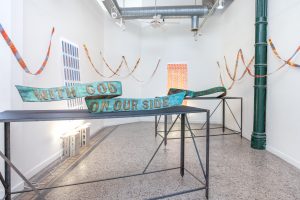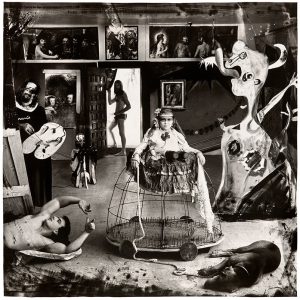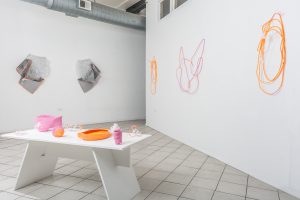![]() During my first exploration of the Chicago Artists Archive I found the extensive file of Phil Berkman, one of the founding members of N.A.M.E. artist collective and gallery space. N.A.M.E. was the avant-garde center of Chicago, showing paintings, sculpture, performance and video work through the 1970s and 1980s. The founding artists claim N.A.M.E. is not an abbreviation for anything, however some in the Chicago arts scene of that time said it stood for “Now All May Exhibit” while the feminist art groups claimed it was an abbreviation for “New All Male Exhibitions”. Berkman’s file is fascinating because it tracks his career (beginning in the 1970s and then tapering off in the 1990s) through articles, press releases for various shows at N.A.M.E., and several copies of his CV. I would like to add that this article is written only from the materials and information I found through in the Archive.
During my first exploration of the Chicago Artists Archive I found the extensive file of Phil Berkman, one of the founding members of N.A.M.E. artist collective and gallery space. N.A.M.E. was the avant-garde center of Chicago, showing paintings, sculpture, performance and video work through the 1970s and 1980s. The founding artists claim N.A.M.E. is not an abbreviation for anything, however some in the Chicago arts scene of that time said it stood for “Now All May Exhibit” while the feminist art groups claimed it was an abbreviation for “New All Male Exhibitions”. Berkman’s file is fascinating because it tracks his career (beginning in the 1970s and then tapering off in the 1990s) through articles, press releases for various shows at N.A.M.E., and several copies of his CV. I would like to add that this article is written only from the materials and information I found through in the Archive.
Berkman’s file is a good mix of information about the individual and the group he helped found. There is an article published in the Chicago Sun-Times in 1988 about Berkman’s career as a gallery guard for the Museum of Contemporary Art of Chicago. His file also contains multiple press releases for N.A.M.E as well as two professional photographs of his work. From what I gathered from his file, Berkman’s work mainly dealt with the recontextualizing of everyday objects by using them as signs for a greater message. He displayed these works both within galleries as well as public art pieces.

In Berkman’s file were several articles and cards for a show entitled “The Members of N.A.M.E. have Agreed to Show Together.” The show opened in their 9 W. Hubbard gallery space in January 1976 and then showed in New York in late February of that same year. The group show featured the art of the eleven N.A.M.E. members of that time: Phil Berkman, Christine Abiera, Barry Holden, Nancy Davidson, Carl Johnson, Othello Anderson, Guy Whitney, Donald Sultan, Jerry Saltz, Mary King, and Joann Elam. Each of these artists, with the exception of Joann Elam, had a file in the Archive, and so my journey through the vast collection continued.

Christine Abiera’s file was not very extensive and for the most part gave the same information about N.A.M.E. that Berman’s folder did. The one exception is a still from her performance piece shown at the member’s show in 1976. There is no other information about the performance, other than being described as involved with “precise control of body movement, rigorous timing, and even some audience conditioning” in a Chicago Tribune review of the show.
Barry Holden was another original member with a great collection of articles and images of his work. Holden’s file features his work from the 1970s, which are large sculptural pieces made of industrial and construction materials, such as 2x4s and dry wall. His pieces are very minimal in aesthetic and allow the material to be what it is, but in a manmade geometric form, and backlit with florescent bulbs (sometimes coloured but not apparent through the images in the file). He explains in one article that he wants to create an ethereal and dramatic effect and that his works “relate directly in placement and indirectly in design with architecture, past and present.” His file was one of my favorites due to the amazing photos and the nature of the work, which speaks to my inner minimalist.

On the subject of photos within the archive files, each photo (and some of the announcement cards) is encased in a plastic in order to protect the images. The plastic has no major effect on the image when viewing in person, but making a photocopy of them does not do the image any justice. Unfortunately, there are no scanners, so if you need a copy of that image, you have to take a picture of the plastic encased photo. This can be an issue if you need that image for a presentation, or you are trying to obtain that image for an article you are writing about that person’s file. So please excuse the quality of some of the images in this article.
Nancy Davidson had a sparse but fairly informative file. She was a Master of Fine Arts graduate from the School of the Art Institute of Chicago (SAIC). For the N.A.M.E. members’ show she created pieces that were installed to a specific interior space and corresponded to how she operated and moved through a space. She would create textures on her paintings by rubbing the canvases on the floor of that specific space. She employed the same technique for a 1975 show at N.A.M.E. called “Systems and Gestures: Translation of Non-Esoteric Information,” which forced Davidson to work within a system in order to create. She worked with blueprints in order to determine the size of the canvas, in this case, paper. She then applied direct rubbings with graphite on paper from the texture of the floor and would hang the paper on wall in an attempt to replace the wall space with information from the floor.
Mary King was also a part of the “Systems and Gestures” show. King’s system was a grid that she applied tally marks to. She set up a numerical sequence and would follow the sequence to completion. For instance, the first group of instructions would mandate she place an oblique slash through the first line while the second group of directions had her place a slash through the last line. This system continued until her grid was covered. According to the afore mentioned Tribune article about the members show, King’s piece dealt with the natural strain layers of paint inflict on wooden panels. The critic was not too keen on that piece stating “A painfully narrow range of expression, this”. The only other items in King’s file are postcards from shows in 2000 and 2003. Her work on the show cards is completely figurative with pattern work within the images, which connects to her earlier pieces. There is no link between her pieces in the 1970s and what she was working on in the 2000s, so there is a huge piece of missing information there.

Carl Johnson is another sparse file showing selective pieces form the 1970s and another selection from the 1990s. In the 1970s, including his piece for the members’ show entitled Scale Conversion, which is a 96 inch tall illustration on paper that corresponds to a stack of tiles placed under the drawing, plays with the relation of 2D and 3D in a minimalist manner. His file abruptly jumps to the 1990s where his work appears to have a folk art mentality. This appears to be a very quirky change from minimal to folk but there is a 20 year gap in which he could have been painting landscapes, nudes, or moved over to sculpture. However, with the information given in the file I’ll just have to image what happened in that time gap.

Othello Anderson had deep roots in Chicago, having attended University of Chicago and received both his BFA and MFA from SAIC. By the 1990s Anderson had worked as an art program consultant at Mt. Sinai Hospital and Mile Square Health Center and as an assistant professor at University of Illinois, Chicago. In the 1970s, he worked in a kind of assemblage manner in which (for his piece for the members’ show) he created works that had paint chips and wood shavings that created a textural variation due to their impermanence. Gradually he became interested in working with more geometrically challenging canvases with his assemblage. Also in his file are postcards and articles about a series of photographs he shot as documentation for Fern Shaffer’s performance series in the 1990s.

Guy Whitney, another SAIC alum, worked primarily in triptychs and multiple canvases “allowing contrasting experience memories and projections to converge on a 3-panel painting.” Though there is not a lot of written information in Whitney’s file, it is rich with show cards and other images. Whitney’s file has three colour pictures of a series of triptychs he did in the 70s. These images show a painter experimenting with colour, texture and a narrative in geometry. For the amount of images in his file, I wish there were some more writings in order to get a better insight into his work.

Donald Sultan has one of the least populated files but one can grasp some understanding of his work. For the members’ show Sultan created three dimensional pieces that were installed on the wall and acted as minimalist paintings. In 1976 he began working with shapes, in particular those made by objects such as hammers, tables, chairs and hands. Then there was a pause in time and in the 1990s and Sultan painted nature and other subjects that are heavy in fauna and landscapes.

Finally, Jerry Saltz, who is now a well-known critic and television personality thanks to Work of Art: The Next Great Artist, was also part of the N.A.M.E. members’ show and an original member. His piece involved thirty-two quotations from Leonardo to Nietzsche that were polled by 100 artists as to which quotations they felt were “best.” A victor emerged, which is unknown through the material in the file, and Saltz’s piece examines the power of aphorisms, democracy and competition. Saltz had a surprisingly small file but one article stood out to me that was pretty apt for Chicago’s recent parting with the Daley administration: in 1978, Saltz invited 100 artists, one third of whom declined, to create a tomb for Richard J. Daley who had died the year before. Barry Holden was part of the show and his piece that resembled Italian stone field huts had little reference to Daley whereas Phyllis Bramson’s “See’n No Evil” is a direct commentary on the late Daley’s rule of Chicago: it depicts a three-headed Daley on a gold, shirred-satin pillow with dollars, women, guns and a shamrock with hands covering the Daleys’ eyes and ears.
Searching through the members of N.A.M.E. cooperative and art gallery, one is given a fairly comprehensive history of the organization and what it stood for. What I gathered from these ten files was that N.A.M.E.’s primary goal was to show work that was different and from young artists. N.A.M.E., to me, is a collaborative art group that helped create the independent/apartment-gallery system and make Chicago a city of opportunity for artists. Installment three of my four-part series will be a look at the archive’s files on Chicago’s artists groups and organizations.


